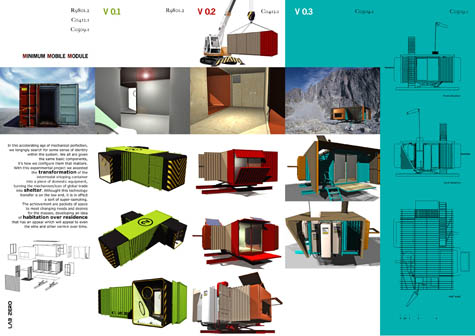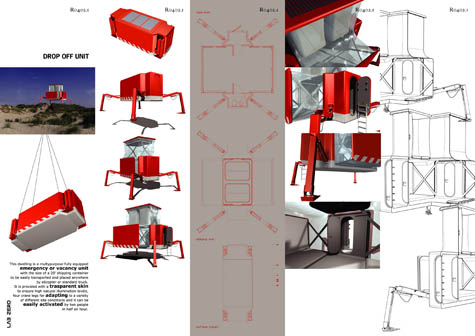 [Image: The solar-powered Minimum Mobile Module by Lab Zero].
[Image: The solar-powered Minimum Mobile Module by Lab Zero].Let me say right away, though, that I know a lot of people are tired of shipping container architecture – in fact, I think most people are tired of shipping container architecture – yet I have a fairly limitless patience for this sort of thing. Actually, I love shipping container architecture.
But the same questions inevitably arise whenever things like this re-appear in the blogosphere: Are shipping containers comfortable? Is reusing them as a form of readymade architecture even structurally realistic? Would anyone really want to raise a family inside one of these things? And does the appeal of such designs actually cross cultures and income levels and ethnicities and, more important, climates? Sure, these might work in Santa Monica – but would they work in Minneapolis-St. Paul?
To which I would have to say that the answer is: no, they probably aren't that comfortable when it comes to raising two and a half kids – and they probably don't equally appeal to, say, bedouins, Russian oil tycoons, Detroit's inner city poor, suburban parents, or even BLDGBLOG readers.
But I don't think those are the right questions to ask.
I don't think the point of cargo container architecture is for us to pretend that it's a universally appropriate design solution for every situation that could possibly exist in the world today – because it isn't. Then again, nothing is universally appropriate in architecture.
What I think is, actually, the point of reusing shipping containers as architecture is: 1) when you can, you should reuse existing materials for somewhat obvious environmental reasons, and 2) the spatial, logical, and combinatorial systems that cargo containers imply are simply awesome. The possibilities excite me. Container-made buildings are fun to look at, they're fun to render, and they're fun to imagine forming new architectural reefs and Tetris cities, interlocking in a sci-fi future coming soon to a landscape near you.
Whole new outer districts of London made from shipping container towers!
 [Image: The Minimum Mobile Module by Lab Zero; view larger].
[Image: The Minimum Mobile Module by Lab Zero; view larger].So arguments about the architectural reuse of shipping containers shouldn't be based on the claim that it's all or nothing; it's not either we replace all existing architecture in the world with cargo containers and then force everyone to live in them or we never construct a single cargo container building anywhere ever again, even for something as simple as a meditation retreat in your own backyard.
Maybe only one cargo container building will ever be built again – or maybe none will – but that doesn't mean we can't still screw around for hours on end with them on our home computers, virtually assembling weird new unfolding structures or houses with legs or helicopter-borne instant cities simply because it's fun and a way to kill time.
In other words, even if these plans serve as nothing but design exercises – studies in volume, combination, and color – then that's fine with me. We can be done with the ongoing arguments and just enjoy looking at cool imagery.
But I digress.
Lab Zero has put together a number of cool projects, including the solar-powered Minimum Mobile Module, pictured above, and the Carapace House, below.
 [Image: The Carapace House by Lab Zero; view larger].
[Image: The Carapace House by Lab Zero; view larger].The Carapace House – a larger diagram of which can be seen here – is intended for use in "challenging natural environments."
Similar to Lab Zero's own Drop Off Unit, the Carapace House is temporary, mobile, and easy to "drop off" in a variety of locations.
 [Image: The Drop Off Unit by Lab Zero; view larger or in more detail].
[Image: The Drop Off Unit by Lab Zero; view larger or in more detail]. All of which brings us to the Jellyfish House – not that Jellyfish House – a kind of floating tower perfect for those of us interested in "spatial delocation."
You can drift around the world's oceans in it, reading William Gibson.
 [Image: The Jellyfish House by Lab Zero; view bigger].
[Image: The Jellyfish House by Lab Zero; view bigger].The Lab Zero website is still apparently under construction, meanwhile, but keep your eye out for more of their work in the future. They were featured in Actar's recent book Self-Sufficient Housing, for instance, and will no doubt be popping up elsewhere soon.
And for more cargo containers on BLDGBLOG see Container Home Kit or even Project Blackbox.
No comments:
Post a Comment